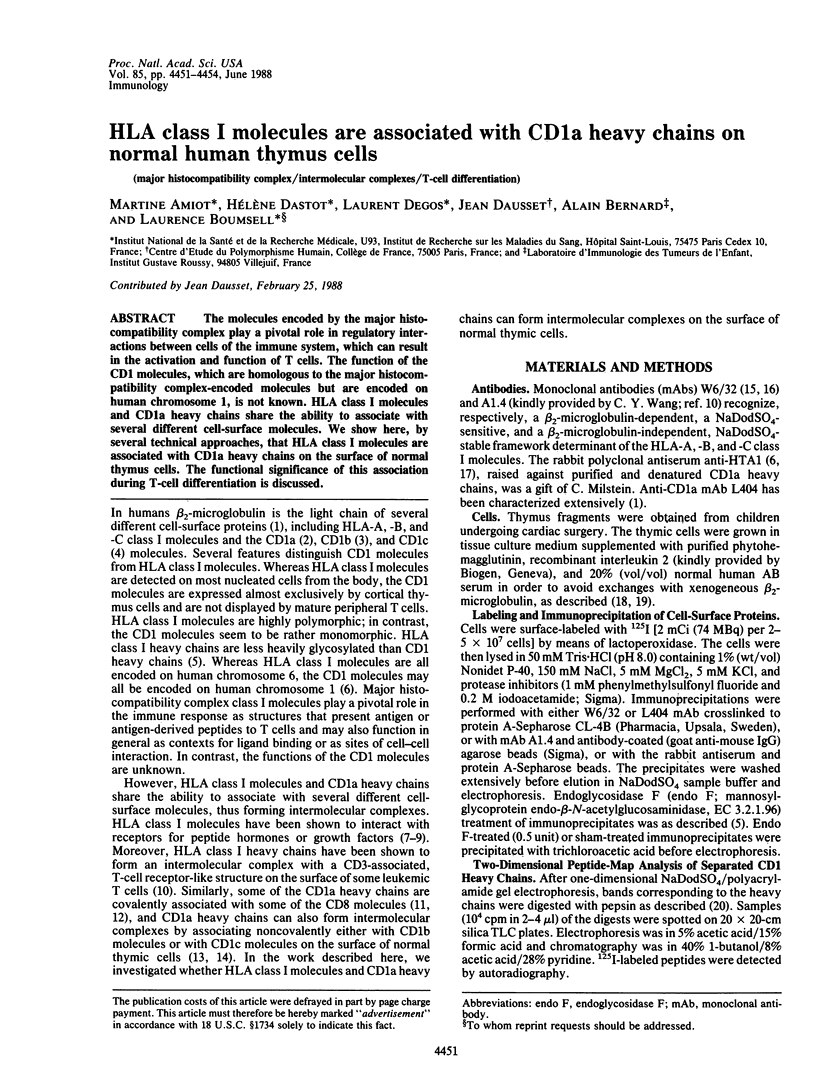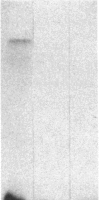Abstract
The molecules encoded by the major histocompatibility complex play a pivotal role in regulatory interactions between cells of the immune system, which can result in the activation and function of T cells. The function of the CD1 molecules, which are homologous to the major histocompatibility complex-encoded molecules but are encoded on human chromosome 1, is not known. HLA class I molecules and CD1a heavy chains share the ability to associate with several different cell-surface molecules. We show here, by several technical approaches, that HLA class I molecules are associated with CD1a heavy chains on the surface of normal thymus cells. The functional significance of this association during T-cell differentiation is discussed.
Full text
PDF



Images in this article
Selected References
These references are in PubMed. This may not be the complete list of references from this article.
- Acuto O., Meuer S. C., Hodgdon J. C., Schlossman S. F., Reinherz E. L. Peptide variability exists within alpha and beta subunits of the T cell receptor for antigen. J Exp Med. 1983 Oct 1;158(4):1368–1373. doi: 10.1084/jem.158.4.1368. [DOI] [PMC free article] [PubMed] [Google Scholar]
- Amiot M., Bernard A., Raynal B., Knapp W., Deschildre C., Boumsell L. Heterogeneity of the first cluster of differentiation: characterization and epitopic mapping of three CD1 molecules on normal human thymus cells. J Immunol. 1986 Mar 1;136(5):1752–1758. [PubMed] [Google Scholar]
- Amiot M., Dastot H., Fabbi M., Degos L., Bernard A., Boumsell L. Intermolecular complexes between three human CD1 molecules on normal thymus cells. Immunogenetics. 1988;27(3):187–195. doi: 10.1007/BF00346585. [DOI] [PubMed] [Google Scholar]
- Amiot M., Dastot H., Schmid M., Bernard A., Boumsell L. Analysis of CD1 molecules on thymus cells and leukemic T lymphoblasts identifies discrete phenotypes and reveals that CD1 intermolecular complexes are observed only on normal cells. Blood. 1987 Sep;70(3):676–685. [PubMed] [Google Scholar]
- Bernabeu C., van de Rijn M., Lerch P. G., Terhorst C. P. Beta 2-microglobulin from serum associates with MHC class I antigens on the surface of cultured cells. Nature. 1984 Apr 12;308(5960):642–645. doi: 10.1038/308642a0. [DOI] [PubMed] [Google Scholar]
- Bushkin Y., Posnett D. N., Pernis B., Wang C. Y. A new HLA-linked T cell membrane molecule, related to the beta chain of the clonotypic receptor, is associated with T3. J Exp Med. 1986 Aug 1;164(2):458–473. doi: 10.1084/jem.164.2.458. [DOI] [PMC free article] [PubMed] [Google Scholar]
- Calabi F., Milstein C. A novel family of human major histocompatibility complex-related genes not mapping to chromosome 6. Nature. 1986 Oct 9;323(6088):540–543. doi: 10.1038/323540a0. [DOI] [PubMed] [Google Scholar]
- Cotner T., Mashimo H., Kung P. C., Goldstein G., Strominger J. L. Human T cell surface antigens bearing a structural relationship to HLA antigens. Proc Natl Acad Sci U S A. 1981 Jun;78(6):3858–3862. doi: 10.1073/pnas.78.6.3858. [DOI] [PMC free article] [PubMed] [Google Scholar]
- Due C., Simonsen M., Olsson L. The major histocompatibility complex class I heavy chain as a structural subunit of the human cell membrane insulin receptor: implications for the range of biological functions of histocompatibility antigens. Proc Natl Acad Sci U S A. 1986 Aug;83(16):6007–6011. doi: 10.1073/pnas.83.16.6007. [DOI] [PMC free article] [PubMed] [Google Scholar]
- Feizi T. Demonstration by monoclonal antibodies that carbohydrate structures of glycoproteins and glycolipids are onco-developmental antigens. Nature. 1985 Mar 7;314(6006):53–57. doi: 10.1038/314053a0. [DOI] [PubMed] [Google Scholar]
- Kahn-Perles B., Boyer C., Arnold B., Sanderson A. R., Ferrier P., Lemonnier F. A. Acquisition of HLA class I W6/32 defined antigenic determinant by heavy chains from different species following association with bovine beta 2-microglobulin. J Immunol. 1987 Apr 1;138(7):2190–2196. [PubMed] [Google Scholar]
- Kefford R. F., Calabi F., Fearnley I. M., Burrone O. R., Milstein C. Serum beta 2-microglobulin binds to a T-cell differentiation antigen and increases its expression. Nature. 1984 Apr 12;308(5960):641–642. doi: 10.1038/308641a0. [DOI] [PubMed] [Google Scholar]
- Knowles R. W., Bodmer W. F. A monoclonal antibody recognizing a human thymus leukemia-like antigen associated with beta 2-microglobulin. Eur J Immunol. 1982 Aug;12(8):676–681. doi: 10.1002/eji.1830120810. [DOI] [PubMed] [Google Scholar]
- Krangel M. S., Bierer B. E., Devlin P., Clabby M., Strominger J. L., McLean J., Brenner M. B. T3 glycoprotein is functional although structurally distinct on human T-cell receptor gamma T lymphocytes. Proc Natl Acad Sci U S A. 1987 Jun;84(11):3817–3821. doi: 10.1073/pnas.84.11.3817. [DOI] [PMC free article] [PubMed] [Google Scholar]
- Lafuse W., Edidin M. Influence of the mouse major histocompatibility complex, H-2, on liver adenylate cyclase activity and on glucagon binding to liver cell membranes. Biochemistry. 1980 Jan 8;19(1):49–54. doi: 10.1021/bi00542a008. [DOI] [PubMed] [Google Scholar]
- Ledbetter J. A., Tsu T. T., Clark E. A. Covalent association between human thymus leukemia-like antigens and CD8(Tp32) molecules. J Immunol. 1985 Jun;134(6):4250–4254. [PubMed] [Google Scholar]
- Martin L. H., Calabi F., Milstein C. Isolation of CD1 genes: a family of major histocompatibility complex-related differentiation antigens. Proc Natl Acad Sci U S A. 1986 Dec;83(23):9154–9158. doi: 10.1073/pnas.83.23.9154. [DOI] [PMC free article] [PubMed] [Google Scholar]
- McMichael A. J., Pilch J. R., Galfré G., Mason D. Y., Fabre J. W., Milstein C. A human thymocyte antigen defined by a hybrid myeloma monoclonal antibody. Eur J Immunol. 1979 Mar;9(3):205–210. doi: 10.1002/eji.1830090307. [DOI] [PubMed] [Google Scholar]
- Olive D., Dubreuil P., Mawas C. Two distinct TL-like molecular subsets defined by monoclonal antibodies on the surface of human thymocytes with different expression on leukemia lines. Immunogenetics. 1984;20(3):253–264. doi: 10.1007/BF00364207. [DOI] [PubMed] [Google Scholar]
- Parham P., Barnstable C. J., Bodmer W. F. Use of a monoclonal antibody (W6/32) in structural studies of HLA-A,B,C, antigens. J Immunol. 1979 Jul;123(1):342–349. [PubMed] [Google Scholar]
- Schreiber A. B., Schlessinger J., Edidin M. Interaction between major histocompatibility complex antigens and epidermal growth factor receptors on human cells. J Cell Biol. 1984 Feb;98(2):725–731. doi: 10.1083/jcb.98.2.725. [DOI] [PMC free article] [PubMed] [Google Scholar]
- Snow P. M., Van de Rijn M., Terhorst C. Association between the human thymic differentiation antigens T6 and T8. Eur J Immunol. 1985 May;15(5):529–532. doi: 10.1002/eji.1830150520. [DOI] [PubMed] [Google Scholar]
- van de Rijn M., Lerch P. G., Knowles R. W., Terhorst C. The thymic differentiation markers T6 and M241 are two unusual MHC class I antigens. J Immunol. 1983 Aug;131(2):851–855. [PubMed] [Google Scholar]





